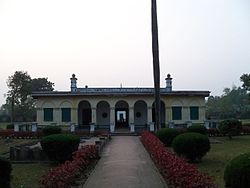| Khoshbagh | |
|---|---|
 Entrance of Khushbagh | |
 | |
| Details | |
| Location | Murshidabad, West Bengal, India |
| Country | India |
| Coordinates | 24°09′45″N88°15′32″E / 24.162610°N 88.258911°E |
| Style | Islamic architecture |
| Size | 7.65 acres |
| No. of graves | Graves of Nawab Siraj ud-Daulah, Lutfunnisa Begum, Nawab Alivardi Khan, Alivardi Khan's mother and other members of the family of the Nawabs of Bengal |
| Website | "Khoshbagh". Archived from the original on 8 January 2019. Retrieved 4 April 2014. |
Khushbagh (also spelled as Khoshbagh; literally "Garden of Happiness") is the garden-cemetery of the Nawabs of Bengal, situated on the west bank of the Hooghly river, about a mile from its east bank, in the Murshidabad-Jiaganj CD block in Lalbag subdivision of Murshidabad district, West Bengal, India. [1] [2] [3] [4] Khushbagh hosts the graves of the Nawabs of Bengal of the Afshar dynasty and their family members; while Jafarganj Cemetery hosts the graves of the later Nawabs and their families, starting from Mir Jafar, who belonged to the Najafi dynasty. Khushbagh is the resting place of Nawab Siraj ud-Daulah, his wife Lutf-un-nisa, Nawab Alivardi Khan, and his mother, amongst others.






